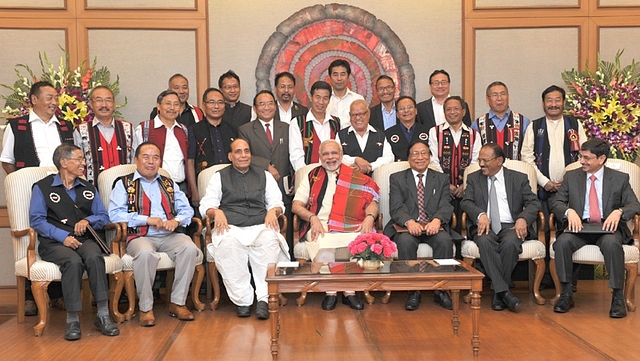
Naga Accord: Asia's Oldest Insurgency Turns A Corner
Asia’s oldest running insurgency has turned a corner. The framework agreement between the Government of India and the Issac-Muivah faction of the National Socialist Council of Nagaland (NSCN-IM), signed on Monday in presence of Prime Minister Narendra Modi and Home Minister Rajnath Singh, is seen as a major breakthrough in the five-decade long Naga insurgency mainly because both sides have shown wisdom and sagacity in accepting each other’s stated positions.
While the Government of India has accepted the ‘uniqueness’ of the Nagas, the Naga leaders have also dropped their demand for sovereignty. A government release in the wake of the signing acknowledged as much when it said: “The sustained dialogue between the two sides, conducted in a spirit of equality, respect and trust, deepened their mutual understanding and confidence, and enabled the two sides to reach an equitable agreement. The Government of India recognized the unique history, culture and position of the Nagas and their sentiments and aspirations. The NSCN understood and appreciated the Indian political system and governance.”
“Today’s agreement is a shining example of what we can achieve when we deal with each other in a spirit of equality and respect, trust and confidence; when we seek to understand concerns and try to address aspirations; when we leave the path of dispute and take the high road of dialogue,” Prime Minister Narendra Modi said after the accord was signed.
RN Ravi, a former Intelligence Bureau official with decades of experience in the north-east affairs, was spot on when he told me:
“This accord restores the pride and dignity of the Nagas who were treated with contempt for decades. The Nagas have as much right over India as India has over the Nagas.”
He said the details of the agreement will be available in three to four weeks. VS Atem, a senior NSCN leader told the Nagaland Post that the NSCN (I-M) has made a “historic agreement” of reconciliation and unity on the basis of political and historical right of the Nagas. He maintained that both Shillong Accord of 1975 and the 16 point agreement of 1960 were not made on the basis of political and historical right of the Nagas.
The pact, coming as it does on the back of an 18-year long ceasefire between NSCN(IM) and the Government of India—and at least 80 rounds of talks—is likely to serve as a foundation for sustained peace in the north-east since the Naga insurgency was seen to be the ‘mother of all insurgencies’ in the region. Once the armed cadres of the NSCN(IM) are integrated with the rest of the society in coming months and the designated camps maintained by the outfit are disbanded, the sustenance it provide to other insurgencies will automatically dissipate.
Although much of the details of the agreement still remain hazy, one understands that both sides have agreed not to disturb the territorial boundaries of the existing states in the region. This should come as a major relief for Manipur which has always feared the dismemberment of the state since the Nagas dominate a major area in the hills of Manipur and had in the past demanded integration of those Naga-inhabited areas into “Greater Nagaland.” However cultural integration of the Nagas spread all over the north-east may be worked out by granting special constitutional protection to them.
The agreement also marks a major triumph for Issac Chisi Swu and T. Muivah, two senior most leaders of the Naga underground movement apart from SS Khaplang, their former comrade-in-arms-turned-bitter-foe. Both have been insurgents since the mid-1960s and even trekked to China to obtain arms in that decade. But in 1997, both took a great risk in agreeing to a ceasefire with the government. For 18 long years, the negotiations traversed a torturous path—teetering on the brink of collapse a number of times—through at least five different regimes at the Centre.
The Khaplang faction of the NSCN, which is currently at loggerheads with the Government, is likely to step up its attacks on various targets in the north-east but given its limited influence in certain pockets, the government is confident of tackling the threat in the short run.
Once the terms of the accord are clear and peace gets embedded in Nagaland, the ripple effects of the agreement is likely to spread to the other parts of the north-east enabling the Centre to implement its ‘Act East’ policy with greater purpose and vigour.
(The writer lived in and reported from India’s north-east between 1983 and 2006)